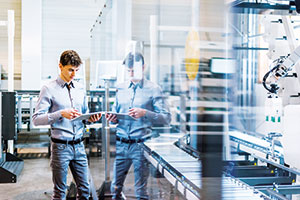

Whether you call it Industry 4.0, the Industrial Internet of Things (IIoT), or Smart Manufacturing, the power of technology is being felt throughout the industrial world and fundamentally changing value chains and production methods. Indeed, so great is the change that Capgemini’s Digital Transformation Institute predicts that smart factories could add as much as $1,5 trillion to the overall output of the industrial sector in the next five years. This is because of the turbocharge effect of smart technology, which is enabling factories to produce more while lowering costs. According to Capgemini, some industries may almost double their operating profit and margin.
What does smart mean?
The National Institute of Standards and Technology (NIST) defines this new landscape as “fully integrated, collaborative manufacturing systems that respond in real time to meet changing demands and conditions in the factory, in the supply network, and in customer needs.” Converging and connected is another way of saying integrated and collaborative. This is where manufacturing benefits from a multiplier effect as operating and information technologies achieve strength in combination and improve efficiency at all levels.
Manufacturing systems are harnessing the full array of new and emerging technologies. The Internet is the foundation, linking equipment, sensors, analytical tools and people in ever more intricate and resourceful ways. Big data, robotics, machine learning, artificial intelligence, augmented reality, 3D printing and predictive analytics: all these things and more are now converging. And with the heightened level of control and oversight that they bring, we can now build a ‘digital twin’ of an entire manufacturing system, and so optimise business performance by creating a real-time profile of a physical object or process.
Lighthouses show the way
The gains from building and operating a smart factory go beyond simply the production of goods. They embrace planning, supply chain logistics, and all aspects of product development and innovation. Businesses that fail to adopt smart manufacturing technologies and practices risk being left behind, which is why we are seeing a growing number of factories worldwide that exemplify the advantages of smart manufacturing.
So, what does the factory of the future look like? The World Economic Forum has highlighted nine of the world’s smartest factories, designating them ‘lighthouses’ that illuminate the benefits of the Fourth Industrial Revolution. That means they have comprehensively deployed smart technologies while keeping people and sustainability at the heart of innovation. Among these models is Schneider Electric’s Le Vaudreuil factory in France.
Leading by example
Le Vaudreuil is a perfect example of converged power and automation. Drawing on Schneider Electric’s EcoStruxure technology, the factory uses a wide range of digital tools to enhance and control operations. EcoStruxure is a versatile and flexible IoT-enabled architecture and platform that connects operating technologies with the latest information technologies.
As soon as you enter the factory, you experience the future of manufacturing. For example, mini data centres store critical site data locally, allowing greater accessibility and security control, all USB keys must pass through a decontamination terminal, and sensors monitor machinery to predict, instead of reacting to, maintenance needs.
Moreover, augmented reality accelerates operations and maintenance, resulting in productivity gains of up to 7 percent, while energy innovations achieve savings of up to 30 percent. This factory not only showcases the benefits of embracing smart technologies but also the ease at which any business can begin its own digital journey.
What’s next for Smart Factories?
The one certainty about smart technology is that it will continue to evolve. We are already talking about Industry 5.0, which will focus on the human element. If Industry 4.0 is about machine and system interconnectivity, Industry 5.0 will see human and machine roles blend and become mutually reinforcing and complementary. This will involve so-called cobots (collaborative robots) working alongside their human counterparts to create combined strengths.
Although machine learning and artificial intelligence are driving smart manufacturing, human input is still essential. While new technologies possess great autonomy, humans must provide direction and control – and apart from overseeing technology, they are needed to gather, compare, analyse and apply data. Technology has a pervasive and growing role, but the key message is that smart factories are empowering the human workforce, not replacing it.
Another important development is the arrival of 5G. It will bring faster downloads and faster responses from applications as a result of lower latency. Sensors will become even more widespread and responsive, and businesses will be able to react to information in real-time. A consortium in the UK is now trialling 5G technology to assess how it can make smart factories even smarter. Among the possible applications are preventive maintenance and controlling machines remotely.
With Industry 4.0 already here, and Industry 5.0 on the way, it is clear that manufacturers who want to remain competitive must embrace the latest digital technologies.
Smart manufacturing – how to add value to your business
The potential of the IIoT lies in the ability to link automation systems with enterprise planning, scheduling and product lifecycle systems. This paper analyses how the linkage can be implemented across the complete enterprise value chain in order to enable greater business control.

© Technews Publishing (Pty) Ltd | All Rights Reserved